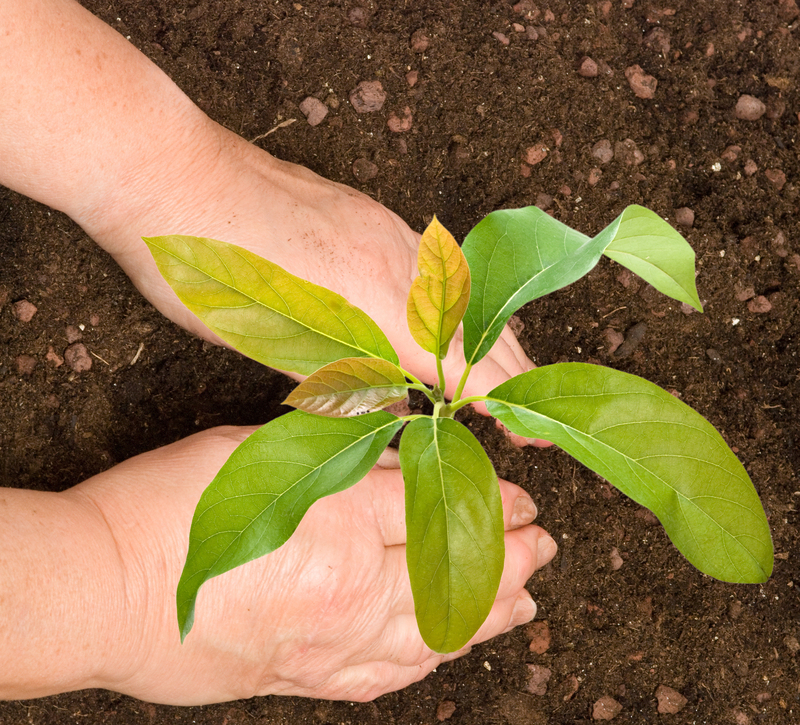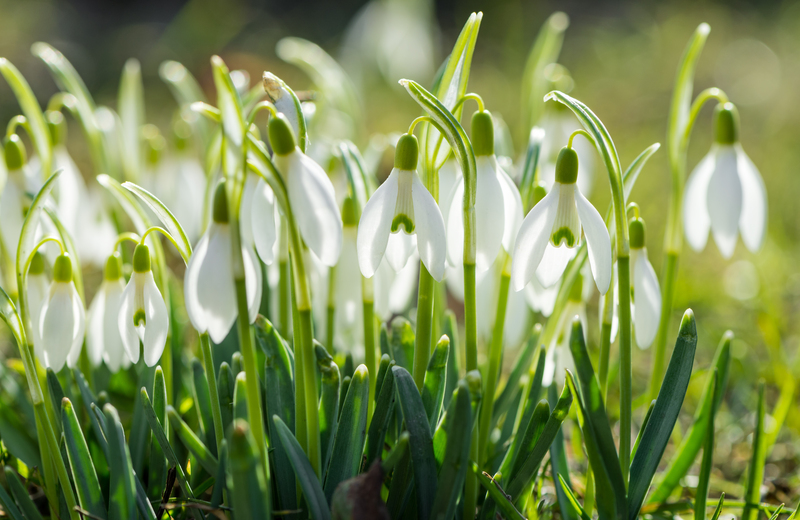Craft a Sensory and Interactive Garden Experience
Posted on 19/08/2025
Craft a Sensory and Interactive Garden Experience: Transform Your Outdoor Space
Are you looking to transform your garden into more than just a visual spectacle? Crafting a sensory and interactive garden experience can turn any outdoor area into a haven for exploration, relaxation, and creativity. Gardens that appeal to all the senses can foster mindfulness, boost well-being, and invite both children and adults to engage deeply with the natural world. In this comprehensive guide, you'll discover how to design, plant, and maintain a multisensory garden that's beautifully interactive and welcoming for every visitor.

What Is a Sensory and Interactive Garden?
A sensory garden is a thoughtfully designed outdoor space that stimulates the five senses: sight, sound, smell, touch, and taste. By intentionally incorporating elements that encourage visitors to interact, these gardens become immersive environments--perfect for relaxation, therapy, and learning. Interactive garden experiences are not just about observation; they encourage touch, movement, listening, and sometimes even tasting, catering to all age groups and abilities.
Why Create a Sensory and Interactive Garden?
- Boosts Mental Health: Engaging the senses in nature helps relieve stress, anxiety, and depression.
- Encourages Learning: Multisensory experiences support cognitive development, especially for children and people with special needs.
- Promotes Inclusivity: These gardens are accessible and enjoyable for people of all abilities, including the elderly and those with disabilities.
- Fosters Bonding and Play: Interactive garden features attract families, friends, and communities to connect outdoors.
Design Principles for a Sensory and Interactive Garden
To craft a sensory and interactive garden experience, planning is essential. Consider the following key design principles:
1. Accessibility and Flow
- Level pathways: Ensure safe, smooth passage for visitors of all mobility levels using wide, even pathways of materials like decomposed granite, pavers, or compacted mulch.
- Zones for exploration: Divide the space into themed sensory zones, each highlighting a different sense or interactive feature.
- Rest areas: Integrate comfortable seating and shade to invite quiet moments and accommodate longer visits.
2. Layering the Senses
| Senses | Garden Elements |
|---|---|
| Sight | Colorful flowers, textured foliage, interesting garden art |
| Sound | Wind chimes, rustling grasses, bird habitats, water features |
| Smell | Fragrant herbs, scented shrubs and blossoms |
| Touch | Varied plant leaf textures, stones, bark, water, sand pits |
| Taste | Edible flowers, fruits, and herbs |
Layer your landscape to target every sense effectively, using the table above as inspiration.
3. Seasonality and Year-Round Interest
- Diverse planting: Include both evergreen and deciduous plants for year-round sensory stimulation.
- Succession planting: Schedule staggered blooms and fruiting to ensure ongoing multisensory appeal.
- Seasonal interactivity: Rotate interactive features or decorations with the seasons to keep experiences fresh and engaging.
4. Safety and Comfort
- Non-toxic plants: Ensure all edible and tactile elements are safe, especially for children and pets.
- Shaded areas: Install pergolas, tree canopy, or shade sails to protect visitors during hot weather.
- Good lighting: Solar or low-voltage lights enhance accessibility and create a magical atmosphere at dusk.
Engaging Every Sense: Practical Ideas
Visual Stimulation in Your Garden
- Bold color palettes: Plant flowers and shrubs with contrasting hues to create vibrant visual displays.
- Ornamental features: Use sculptures, art installations, or colorful pots to add visual intrigue.
- Movable elements: Add wind spinners, hanging glass, or kinetic sculpture that dance in the breeze, drawing the eye.
Incorporating Sound for a Dynamic Space
- Natural water features: Small fountains, streams, or bubbling pots produce soothing sounds and attract wildlife.
- Grasses and bamboo: Tall, rustling plants add a gentle music as wind blows through them.
- Wind chimes and musical sculptures: Install at varying heights and locations for layered acoustic effects.
- Wildlife habitats: Bird and insect houses invite creatures whose songs fill your garden with life.
Fragrance: Scents to Remember
- Scented blooms: Roses, gardenias, and jasmine offer intense floral odors.
- Aromatic herbs: Plant lavender, mint, thyme, and basil along paths for easy brushing and enjoying their fresh perfume.
- Seasonal intrigue: Add bulbs like hyacinth in spring and fragrant evergreens like pine for winter scent.
Tactile Encounters for All Ages
- Soft and fuzzy leaves: Stachys byzantina (lamb's ear), mullein, or moss offer velvety textures.
- Rough and spiky bark: Experiment with different tree and shrub species for unique bark contrasts.
- Sand, pebbles, and water: Sandbox stations or pebble mosaics let fingers and toes dig in, while small water courses or misting stations cool and refresh.
- Interactive sensory paths: Create barefoot-friendly trails with alternating materials for a fun, full-body experience.
Taste: Edible Landscaping for Interaction
- Snack-friendly plantings: Include fruiting bushes (blueberry, currant), cherry tomatoes, and berry canes along pathways.
- Herb spiral or raised beds: Encourage visitors to pick and savor basil, dill, sage, or edible flowers like nasturtiums.
- Seasonal harvest area: Dedicated beds for strawberries, carrots, or peas provide hands-on growing and tasting experiences, especially for children.
Tips to Maximize Interactivity
Design with Engagement in Mind
- Collaboration spaces: Include tables for potting, painting, or crafting surrounded by sensory plantings.
- Discovery elements: Hide "treasures," like painted rocks or fairy houses, for scavenger hunts and imaginative play.
- Gardening together: Raised beds or community plots invite group gardening--ideal for schools, therapy centers, or neighborhoods.
- Moveable play structures: Wooden balance beams, log steps, or simple obstacle courses integrate movement with natural beauty.
Educational and Therapeutic Features
- Braille labels and audio tours: Make plant ID and garden information accessible to all.
- Mindfulness stations: Dedicate spaces for yoga, meditation, or quiet reflection amid calming plants and soothing sounds.
- Gardening therapy areas: Raised beds, ergonomic tools, and wide paths enable everyone--including wheelchair users--to engage with planting and harvesting.
Garden Maintenance for the Senses
Maintaining a multisensory interactive garden means more than routine weeding and watering. Foster continual engagement with these best practices:
- Regular plant assessments: Check for overgrowth, faded blooms, or injured branches to keep sensory plantings healthy and vibrant.
- Seasonal refreshes: Rotate annuals, decorate with seasonal art, and install temporary pop-up features for year-round appeal.
- Cleanliness: Keep seating, play areas, and paths tidy and safe, especially after bad weather.
- Wildlife care: Replenish bird feeders, clean baths, and refresh nectar plants to attract beneficial visitors.
- Visitor feedback: Use guestbooks or suggestion boards to learn which experiences resonate best and what can be improved.
Plants and Materials for Your Sensory & Interactive Garden
Top Plant Choices
- For sight: Sunflowers, zinnias, Japanese maples, hellebores, ornamental kale
- For touch: Lamb's ear, ferns, ornamental grasses, bamboo, moss
- For sound: Bamboo, miscanthus, fountain grass, water lilies, willow trees
- For smell: Lavender, thyme, scented geraniums, sweet peas, honeysuckle
- For taste: Blueberries, strawberries, French sorrel, chives, nasturtiums
Interactive Features & Materials
- Natural elements: Logs, pebbles, driftwood, and sand for textural trails
- Water: Birdbaths, child-safe bubbling fountains, misting jets
- Garden art: Shimmering mobiles, wind-powered sculptures, painted stepping-stones
- Sensory play tools: Baskets for harvesting, bug viewers, scent jars, musical instruments
- Accessibility aids: Raised planters, textured railings, wide ramps
Example Layout: A Sample Sensory and Interactive Garden Plan
Below is a sample plan to help you craft a sensory and interactive garden experience in your backyard or community space:
- Entry Path: Lined with tall sunflowers, scented geraniums, and wind chimes for instant impact.
- Sensory Bed: Cluster tactile (lamb's ear, mint), scented (lavender, sage), and colorful plants together, with mulched paths for barefoot exploration.
- Pond Corner: Install a small pond or bubbling pot for water sounds, ringed with edible herbs and birdhouses.
- Edible Alley: Low berry bushes, tomatoes, nasturtiums, and salad greens for nibbling and harvesting.
- Interactive Seating Area: Table with fragrant centerpiece (rosemary, basil), surrounded by tactile-friendly ground covers and moveable art sculptures.
- Quiet Retreat: Hedges for privacy and shaded bench for reflection amid calming foliage.
- Children's Discovery Nook: Sandbox, shallow water table, sensory pathways, hidden fairy doors, and places to dig and build.

Final Touches: Personalizing Your Sensory Garden Experience
- Bring in your story: Use family heirloom plants, cultural features, or art that reflects your community.
- Change with seasons: Add autumn displays, winter lighting, spring bulbs, or summer festival decorations to keep the space dynamic all year.
- Host events: Organize garden yoga, story time for kids, sensory walks, or edible plant workshops to create ongoing interaction.
- Document your journey: Use photos, journals, or online blogs to inspire others and track your evolving sensory haven.
Conclusion: Discover the Joy of a Sensory and Interactive Garden
Crafting a sensory and interactive garden is an invitation to see, hear, touch, smell, and taste nature in new and memorable ways. Whether you're a home gardener, educator, healer, or community leader, multisensory outdoor spaces offer endless returns in wellness, creativity, and connection. Transform your landscape into a vibrant, inclusive environment by combining thoughtful plant selection, interactive features, and intentional design--turning your garden into an ever-changing world of discovery for all ages and abilities.
Start planning today, and soon you'll enjoy the lasting rewards of your own sensory and interactive garden experience!

